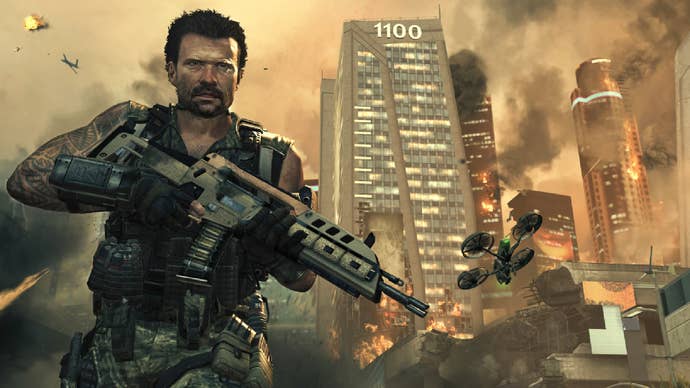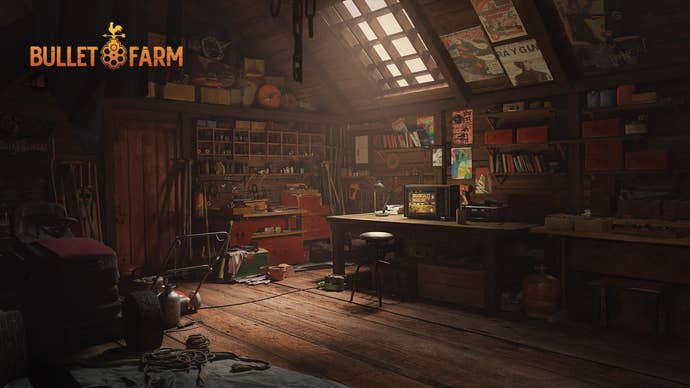Products You May Like
When you’ve made some of the biggest games on the planet, juggling budgets of millions of dollars and selling millions of copies, what comes next?
For David Vonderhaar it was nearly a year off in an RV with his dog; but then he decided to do it all again – only on his terms this time around.
After stepping away from Treyarch, where he served as multiplayer design director on the legendary Call of Duty: World at War before moving up to studio design director on the subsequent Black Ops franchise, Vonderhaar is now ramping up a new studio, BulletFarm, under the banner of NetEase Games.
“I don’t want to be an annualised, sequelised, battle pass-ed infinity game,” Vonderhaar says of BulletFarm’s (eventual) first release.
“I think it’s destructive to creatives and I don’t think it’s super-healthy for gamers, either. I think having diversity in what we play is better for entertainment in general. If there’re only five franchises in the world and that’s all you can watch, what are you missing? What new ideas?
“I’ve been on record that I don’t want to operate that way. I don’t want to make a game that’s sequelised for 10 years. I’ve already done that. I don’t need to do that again. I did it with a bunch of other people who were very hard working, but we’ve been there. It’s time to do the new version of that, whatever shape it takes.”
While the finer details still need to be tested and hammered out, Vonderhaar comes from a shooter background and shooters are what BulletFarm is going to make – if you couldn’t already tell that from the studio being a literal farm, for bullets.
It’s a crowded landscape, and one that’s dominated by massive properties, not least the ones Vonderhaar used to work on. But even though BulletFarm is a new studio, it’s not an indie one. So where many game developers with a strong profile transition to making games with a smaller scope, BulletFarm was immediately tagged with the “AAA” label, tasked with delivering eye-catching experiences for NetEase.
“Why not? Do you want to be a C studio?” Vonderhaar jokes when I ask about the decision to frame BulletFarm that way.
“It was natural. This is what we’re from, this is what we’ve worked on, so subconsciously I wanted to put that label on us so we’d perform that way. But we do put these big statements in play and that gives us this constant thing to go for.
“If we’ve said that, we have to make that true. We’re going to make sure that our ideas are solid and prototyped. We’re not going to tell the world that we’re making ‘this’, then spend a year on it and have to lie about it because it didn’t work out.”
Realistic expectations seem to be a core part of BulletFarm’s mission statement, both from the perspective of maintaining sustainable, high-quality development (which is becoming a bigger and bigger consideration in the AAA space) and building a reputation and brand.

Vonderhaar is aiming for an initial headcount of 15-20 – not 150 – with BulletFarm leaning on NetEase’s wider ecosystem of external development resources to concept and prototype its first game over the course of the next year.
That game has already been announced as something of a departure from Vonderhaar’s previous work. We know it’s going to be a first-person experience and a shooter set in an “original universe” (that’s a new IP), but before its unique selling points have been properly tested, it’s easier to define the specifics of what a BulletFarm game isn’t, than precisely what it is.
“I could tell you exactly why I think it’s different now, but ask me again in a year when the prototype’s done so that when I give you the answer that’s not what I hope and dream but what it actually is,” Vonderhaar explains.
“But to not dance around that question, most shooters – especially military shooters – are about shooting as many bullets as you can into as many people as you can, as fast as you can, for as long as you can for the rest of your life. That’s the core of that game; you can claim there’s a game mode, you can claim there’s a mission, but you’re ultimately just shooting and shooting and shooting.
“I think what we want to do is a lot more intimate than that, something that’s not necessarily just about shooting. It doesn’t have to be like that, we’re not competing with mil-sims, we don’t want to make a mil-sim, we want to make a game where the shooting matters more than it does today. You can argue when once you’ve killed the 400th guy on-screen, do you even care anymore?
“In a way it’s anti-those kind of games. Let’s be honest; I worked on those kinds of games for 18 years and I was pretty happy with that. I think it’s time for us as a group to evolve and try something a little bit more interesting and different from that particular game loop.”

Both World at War and Black Ops are well-remembered for their multiplayer (Kar98k and Nuketown 4eva), so it’s easy to forget that there were a ton of great campaigns in there too. Highlights include the endlessly quotable original Black Ops (the numbers, Mason), then there was the insane ending to Black Ops 3 and the ambitious, divergent choices of Black Ops: Cold War.
We also know that BulletFarm’s game has been billed as “cooperative”, and with Vonderhaar’s multiplayer pedigree, you’d be forgiven for jumping to that meaning a game that’s exclusively multiplayer-focused, but that doesn’t look to be the case.
“The answer that you probably won’t like is that we have a very unique take on how to do co-op: it’s neither of those two things, it’s something in-between,” Vonderhaar says of whether BulletFarm’s first game will be multiplayer or narrative-led.
“That’s all you get on that, because again, I have to make sure this idea works.
“I am not the kind of guy that wants to go out to the world and promise the moon and not deliver that moon. That’s not how we roll and not what we’re going to do. I don’t want to overpromise and underdeliver. I want to promise and overdeliver.”
“What I’ve seen over the years in my experience is that the most innovation, the newest thinking, the greatest ideas and the biggest push of technology in video gaming isn’t from the mainline, core, massive IP, it’s the smaller initiatives: how Blackout becomes Warzone, how CoD Zombies existed, those types of initiatives.
“They’re not built in that grand thing, they’re built by a smaller group, a subset of people working passionately and everyone’s very close. The philosophy that’s being reflected is really just what Chris [Cowell, BulletFarm creative director] and I have about that mentality of when you’re working. That’s when amazing things can happen, I’ve seen it and witnessed it.”

So when World at War’s biggest lasting legacy is its Zombies mode, which came to be Treyarch’s return ace in its annualised Call of Duty tennis match with Infinity Ward, there must have been a temptation to try and reboot that core concept outside of the Activision creative framework – in a similar way to how Turtle Rock Studios’ made Back 4 Blood as a spiritual Left 4 Dead successor post-Valve.
But that seems to run counter to the creative ethos that pulled Vonderhaar back into leading BulletFarm in the first place, when nearly two decades of similar projects had left him searching for a new challenge.
“Specific in terms of the game, the game mechanics, loop and features, I don’t think so. But when you talk about the philosophy of how you create Zombies and how we’re creating what we’re making, there’s an 85% overlap,” Vonderhaar explains when I ask if there will be any links between BulletFarm’s games and CoD Zombies.
“When I talk about working on Zombies or Blackout, those are two modes in particular that Chris and I have worked on together or separately and how you go about that, how you go about the creative and what you let exist and the rule framework, it’s much more fluid and flexible. That model of working a lot, the game not specifically.
“I don’t think you recapture that vibe by doing what you did 10 years ago. You get that vibe because it’s the first time like it was for us then. Trying to chase expectations of our past is, I think, a losing proposition for us and for fans of us and our games. We’re going to do something new, it’s not going to be exactly what you’ve seen, you can count on the lineage and the tradition and the history, but not the game, we’re going to bring something new for you to be excited and passionate about and want to participate in.”

However, while BulletFarm is a brand-new studio that’s, hopefully, working on some brand-new ideas that take time to produce, we might be able to expect some more concrete details sooner rather than later.
“I’ve thought about this a lot,” Vonderhaar says on how BulletFarm will stand out in the shooter genre.
“I’ll tell you what we’re not doing: we’re not going to compete with Call of Duty. We’re not going to go after what they do because that’s a losing battle. What that leaves us is the resources, team strength, and experience of AAA to carve out an area that’s underrepresented and we have a very, very specific vision for how to do that.
“I’m not prepared to give the world a timeline or a timetable, we’re spinning up on Unreal 5, there’s a lot here.
“But I do tell you this much: we’re not ones to sit around and debate it forever. We make sharp, fast, crisp decisions and get to work. I think we’re going to move a lot faster than a lot of people have by comparison, but it’s not going to be tomorrow, we’ve got to get spun up.”
